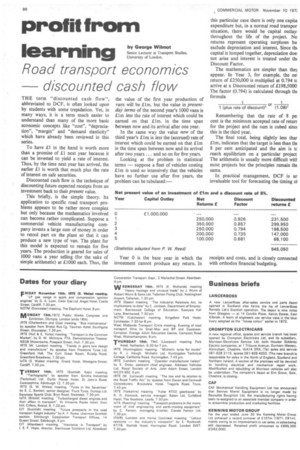profit from learning
Page 84

If you've noticed an error in this article please click here to report it so we can fix it.
by George Wilmot
Senior Lecturer in Transport Studies, University of London.
Road transport economics discounted cash flow
THE term "discounted cash flow", abbreviated to DCF, is often looked upon by students with some trepidation. Yet, in many ways, it is a term much easier to understand than many of the more basic economic concepts like "cost", "depreciation", "margin" and "demand elasticity" which have already been reviewed in this series.
To have £1 in the hand is worth more than a promise of £1 next year because it can be invested to yield a rate of interest. Thus, by the time next year has arrived, the earlier El is worth that much plus the rate of interest on safe securities.
Discounted cash flow is the technique of discounting future expected receipts from an investment back to their present value.
This briefly, is the simple theory. Its application to specific road transport problems appears to be rather more complex but only because the mathematics involved can become rather complicated. Suppose a commercial vehicle manufacturing company invests a large sum of money in order to retool part ox the plant so that it can produce a new type of van. The plant for this model is expected to remain for five years. The production is geared for sales of 1000 vans a year selling (for the sake of simple arithmetic) at £1000 each. Thus, the
the value of the first year production of vans will be Elm. but the value in presentday terms of the second year's 1000 vans is Lim less the rate of interest which could be earned on that Elm. in the time span between now and its arrival after one year.
In the same way the value now of the third year's Lim is less the (accrued) rate of interest which could be earned on that Elm in the time span between now and its arrival after two years . . . and so on for five years.
Looking at the problem in statistical terms suppose a fleet of vehicles costing Elm is used so intensively that the vehicles have no further use after five years, the problem can be tabulated: this particular case there is only one capita expenditure but, in a normal road transpor situation, there would be capital outlay: throughout the life of the project. Ne returns represent operating surpluses bu exclude depreciation and interest. Since du capital is lumped together, depreciation doet not arise and interest is treated under thi Discount Factor.
The mathematics are simpler than the3 appear. In Year 3, for example, the net return of £250,000 is multiplied at 0.794 tc arrive at a Discounted return of £198,5000 The factor (0.794) is calculated through tlu formula
1 Or 1 (plus rate of discount)3 (1.08)3
Remembering that the rate of 8 pet cent is the minimum accepted rate of returr for the project and the sum is cubed sine( this is the third year.
The final total, being slightly less thar Elm, indicates that the target is less than tlu 8 per cent anticipated and the aim is tc reach equilibrium on a particular project The arithmetic is usually more difficult wit!: most projects but the principles remain the same.
In practical management, DCF is an invaluable tool for forecasting the timing oi




































































































































